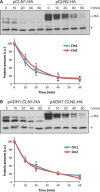A comparative study of the degradation of yeast cyclins Cln1 and Cln2
- PMID: 28097090
- PMCID: PMC5221467
- DOI: 10.1002/2211-5463.12157
A comparative study of the degradation of yeast cyclins Cln1 and Cln2
Abstract
The yeast cyclins Cln1 and Cln2 are very similar in both sequence and function, but some differences in their functionality and localization have been recently described. The control of Cln1 and Cln2 cellular levels is crucial for proper cell cycle initiation. In this work, we analyzed the degradation patterns of Cln1 and Cln2 in order to further investigate the possible differences between them. Both cyclins show the same half-life but, while Cln2 degradation depends on ubiquitin ligases SCFGrr1 and SCFCdc4, Cln1 is affected only by SCFGrr1. Degradation analysis of chimeric cyclins, constructed by combining fragments from Cln1 and Cln2, identifies the N-terminal sequence of the proteins as responsible of the cyclin degradation pattern. In particular, the N-terminal region of Cln2 is required to mediate degradation by SCFCdc4. This region is involved in nuclear import of Cln1 and Cln2, which suggests that differences in degradation may be due to differences in localization. Moreover, a comparison of the cyclins that differ only in the presence of the Cln2 nuclear export signal indicates a greater instability of exported cyclins, thus reinforcing the idea that cyclin stability is influenced by their localization.
Keywords: Cln1; Cln2; SCF ubiquitin ligase; Saccharomyces cerevisiae; cell cycle; cyclin.
Figures








Similar articles
-
Molecular basis of the functional distinction between Cln1 and Cln2 cyclins.Cell Cycle. 2012 Aug 15;11(16):3117-31. doi: 10.4161/cc.21505. Epub 2012 Aug 14. Cell Cycle. 2012. PMID: 22889732 Free PMC article.
-
Delayed accumulation of the yeast G1 cyclins Cln1 and Cln2 and the F-box protein Grr1 in response to glucose.Yeast. 2007 May;24(5):419-29. doi: 10.1002/yea.1472. Yeast. 2007. PMID: 17366522
-
An essential function of Grr1 for the degradation of Cln2 is to act as a binding core that links Cln2 to Skp1.J Cell Sci. 1998 Dec 18;111 ( Pt 24):3655-61. doi: 10.1242/jcs.111.24.3655. J Cell Sci. 1998. PMID: 9819356
-
G1 cyclin degradation: the PEST motif of yeast Cln2 is necessary, but not sufficient, for rapid protein turnover.Mol Cell Biol. 1994 Dec;14(12):7953-66. doi: 10.1128/mcb.14.12.7953-7966.1994. Mol Cell Biol. 1994. PMID: 7969135 Free PMC article.
-
Karyopherin Msn5 is involved in a novel mechanism controlling the cellular level of cell cycle regulators Cln2 and Swi5.Cell Cycle. 2019 Mar;18(5):580-595. doi: 10.1080/15384101.2019.1578148. Epub 2019 Feb 11. Cell Cycle. 2019. PMID: 30739521 Free PMC article.
Cited by
-
A transcriptome-wide analysis deciphers distinct roles of G1 cyclins in temporal organization of the yeast cell cycle.Sci Rep. 2019 Mar 4;9(1):3343. doi: 10.1038/s41598-019-39850-7. Sci Rep. 2019. PMID: 30833602 Free PMC article.
-
Multisite phosphorylation by Cdk1 initiates delayed negative feedback to control mitotic transcription.Curr Biol. 2022 Jan 10;32(1):256-263.e4. doi: 10.1016/j.cub.2021.11.001. Epub 2021 Nov 23. Curr Biol. 2022. PMID: 34818519 Free PMC article.
-
Enhancement of LacI binding in vivo.Nucleic Acids Res. 2019 Oct 10;47(18):9609-9618. doi: 10.1093/nar/gkz698. Nucleic Acids Res. 2019. PMID: 31396617 Free PMC article.
-
Comprehensive and quantitative analysis of G1 cyclins. A tool for studying the cell cycle.PLoS One. 2019 Jun 25;14(6):e0218531. doi: 10.1371/journal.pone.0218531. eCollection 2019. PLoS One. 2019. PMID: 31237904 Free PMC article.
References
-
- Andrews B and Measday V (1998) The cyclin family of budding yeast: abundant use of a good idea. Trends Genet 14, 66–72. - PubMed
-
- Breeden LL (2003) Periodic transcription: a cycle within a cycle. Curr Biol 13, R31–R38. - PubMed
-
- McInerny CJ (2011) Cell cycle regulated gene expression in yeasts. Adv Genet 73, 51–85. - PubMed
-
- Simon I, Barnett J, Hannett N, Harbison CT, Rinaldi NJ, Volkert TL, Wyrick JJ, Zeitlinger J, Gifford DK, Jaakkola TS et al (2001) Serial regulation of transcriptional regulators in the yeast cell cycle. Cell 106, 697–708. - PubMed
LinkOut - more resources
Full Text Sources
Other Literature Sources

